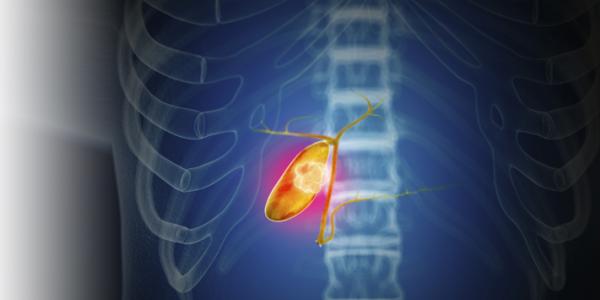


You may have heard of the gallbladder but, if you're like many people, you probably don't actually know what role it plays in your health. Trust us, you're not alone! This pear-shaped organ is located just underneath your liver and, unless you've had something go wrong, you probably don't think too much about it. However, it's important to understand the basics so you can recognize the symptoms if they do occur. Read on to learn everything you need to know about gallbladder attacks.
Your gallbladder is an important part of the digestion process, as it is responsible for storing and concentrating bile – a fluid made by the liver that's used to digest fat. When you eat, bile is released from the liver into your small intestine via small tubes (called bile ducts). This bile helps your body break down and absorb fats from the food you eat. In between meals – when there’s no fat to be digested – extra bile flows to the gallbladder, where it is stored and concentrated. When you eat fatty foods, your gallbladder pushes bile through the bile duct into the small intestine, where it mixes into the already partially-digested food and aids in further digestion.
Bile is mostly water, but it also contains waste products including cholesterol and bile salts. Bile salts not only help your body digest fat, but they also keep the cholesterol from becoming solid. When the ratio of cholesterol to bile salts is too high, the cholesterol can turn from liquid to solid and result in gallstones.
Gallstones range from as small as a grain of sand to (in extreme cases) as large as a golf ball. Typically, gallstones remain in the gallbladder and don't cause any harm. In fact, 15-20% of adults have some amount of gallstones present — most without ever knowing it! The presence of gallstones alone isn’t cause for treatment, however, they can become problematic if they cause painful symptoms.
Anyone can develop gallstones, however, researchers have identified some factors that could increase your risk, including:
Often, gallstones don't cause any symptoms. However, when they get bigger or start to obstruct the bile ducts, you may develop painful symptoms — often referred to as "attacks." These attacks often occur at night, typically after eating a fatty meal. Common symptoms of a gallbladder attack include sudden, intense pain in the upper abdomen, often with nausea and vomiting.
Gallstone pain lasts anywhere from a few minutes to a few hours — however long it takes for the stone to pass. However, if it continues to block the bile ducts, it could cause other issues (in addition to severe, prolonged pain) that may require surgery. If you experience symptoms of a gallbladder attack, it's important to seek medical attention in order to assess your condition and determine if additional treatment is needed — especially if the pain lasts more than 2-3 hours.
Gallbladder attacks are so painful that they send more than a million people to the emergency room each year. If the gallstone can pass on its own, medication can be used to ease the pain in the process. If the stone doesn't pass on its own — which can lead to complications such as infection and inflammation — or if you frequently develop gallstones, a minimally-invasive procedure may need to be performed to remove the gallbladder.
The digestive health experts at El Camino Health use the most advanced diagnostic tests and treatments available to identify and treat gallbladder and bile duct conditions. We use the least invasive procedures possible to lower complication rates, lessen the need for pain medication and get you back to normal activities more quickly. Learn more about our advanced treatment options.
While no one can fully eliminate their risk of gallstones, there are still things you can do to reduce your chances — and improve your overall health in the process! Here are some of the best lifestyle changes you can make to help reduce your risk of painful gallstones:
This article first appeared in the October 2022 edition of the HealthPerks newsletter.

Identify your risk factors and what to do if you are at risk.